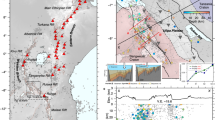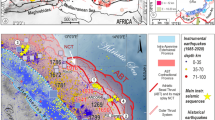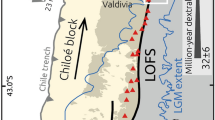Abstract
Continental rifts begin and develop through repeated episodes of faulting and magmatism, but strain partitioning between faulting and magmatism during discrete rifting episodes remains poorly documented. In highly evolved rifts, tensile stresses from far-field plate motions accumulate over decades before being released during relatively short time intervals by faulting and magmatic intrusions1,2,3. These rifting crises are rarely observed in thick lithosphere during the initial stages of rifting. Here we show that most of the strain during the July–August 2007 seismic crisis in the weakly extended Natron rift, Tanzania, was released aseismically. Deformation was achieved by slow slip on a normal fault that promoted subsequent dyke intrusion by stress unclamping. This event provides compelling evidence for strain accommodation by magma intrusion, in addition to slip along normal faults, during the initial stages of continental rifting and before significant crustal thinning.
This is a preview of subscription content, access via your institution
Access options
Subscribe to this journal
Receive 51 print issues and online access
$199.00 per year
only $3.90 per issue
Buy this article
- Purchase on Springer Link
- Instant access to full article PDF
Prices may be subject to local taxes which are calculated during checkout




Similar content being viewed by others
References
Heki, K., Foulger, G., Julian, B. & Jahn, C. H. Plate dynamics near divergent boundaries: Geophysical implications of postrifting crustal deformation in NE Iceland. J. Geophys. Res. 98, 14279–14297 (1993)
Cattin, R. et al. Numerical modelling of Quaternary deformation and post-rifting displacement in the Asal–Ghoubbet rift (Djibouti, Africa). Earth Planet. Sci. Lett. 239, 352–367 (2005)
Wright, T. J. et al. Magma-maintained rift segmentation at continental rupture in the 2005 Afar dyking episode. Nature 442, 291–294 (2006)
Baer, G., Hamiel, Y., Shamir, G. & Nof, R. Evolution of a magma-driven earthquake swarm and triggering of the nearby Oldoinyo Lengai eruption, as resolved by InSAR, ground observations, and elastic modelling, East African Rift, 2007. Earth Planet. Sci. Lett. 272 10.1016/j.epsl.2008.04.052 (2008)
Ebinger, C. J., Poudjom Djomani, Y., Mbede, E., Foster, A. N. & Dawson, J. B. Rifting Archean lithosphere: Eyasi–Manyara–Natron rifts, East Africa. J. Geol. Soc. Lond. 154, 947–960 (1997)
Stamps, D. S. et al. A kinematic model for the East African Rift. Geophys. Res. Letters 35 10.1029/ 2007GL032781 (2008)
Birt, C. et al. The influence of pre-existing structures on the evolution of the southern Kenya rift valley – Evidence from seismic and gravity studies. Tectonophysics 278, 211–242 (1997)
Green, W. V., Achauer, U. & Meyer, R. P. A three-dimensional seismic image of the crust and upper mantle beneath the Kenya rift. Nature 354, 199–203 (1991)
Nyblade, A. A., Owens, T. J., Gurrola, H., Ritsema, J. & Langston, C. A. Seismic evidence for a deep upper mantle thermal anomaly beneath East Africa. Geology 7, 599–602 (2000)
Vaughan, R. G., Kervyn, M., Realmuto, V., Abrams, M. & Hook, S. J. Satellite measurements of recent volcanic activity at Oldoinyo Lengai, Tanzania. J. Volcanol. Geotherm. Res. 173, 196–206 (2008)
Dawson, J. B., Bowden, P. & Clark, G. C. Activity of the carbonatite volcano, Oldoinyo Lengai, 1966. Geol. Rundsch. 57, 865–879 (1968)
Rubin, A. Dike-induced faulting and graben subsidence in volcanic rift zones. J. Geophys. Res. 92, 1839–1858 (1992)
Okada, Y. Internal deformation due to shear and tensile faults in a half-space. Bull. Seismol. Soc. Am. 82, 1018–1040 (1992)
Mogi, K. Relations between the eruptions of various volcanoes and the deformations of the ground surfaces around them. Bull. Earthq. Res. Inst. Tokyo 36, 99–134 (1958)
Amelung, F., Yun, S.-H., Walter, T. R., Segall, P. & Kim, S. W. Stress control of deep rift intrusion at Mauna Loa volcano, Hawaii. Science 316, 1026–1030 (2007)
Vauchez, A., Dineur, F. & Rudnick, R. Microstructure, texture and seismic anisotropy of the lithospheric mantle above a mantle plume: Insights from the Labait volcano xenoliths (Tanzania). Earth Planet. Sci. Lett. 232, 295–314 (2005)
Ibs-von Seht, M., Blumenstein, S., Wagner, R., Hollnack, D. & Wohlenberg, J. Seismicity, seismotectonics and crustal structure of the southern Kenya Rift - new data from the Lake Magadi area. Geophys. J. Int. 146, 439–453 (2001)
Tongue, J., Maguire, P. K. H. & Burton, P. An earthquake study in the Lake Baringo basin of the central Kenya Rift. Tectonophysics 236, 151–164 (1994)
Nyblade, A. A., Birt, C., Langston, C. A., Owens, T. J. & Last, R. J. Seismic experiment reveals rifting of craton in Tanzania. Eos 77, 517–521 (1996)
Buck, W. R. in Rheology and Deformation of the Lithosphere at Continental Margins (eds Karner, G. D., Taylor, B., Driscoll, N. & Kohlstedt, D.) 1–30 (Columbia Univ. Press, 2004)
Lienert, B. R. E. & Havskov, J. A computer program for locating earthquakes both locally and globally. Seismol. Res. Lett. 66, 26–36 (1995)
KRISP Working Party. Large-scale variation in lithospheric structure along and across the Kenya rift. Nature 354, 223–227 (1991)
Massonnet, D. & Feigl, K. L. Radar interferometry and its application to changes in the Earth’s surface. Rev. Geophys. 36, 441–500 (1998)
Chen, C. W. & Zebker, H. A. Two-dimensional phase unwrapping with use of statistical models for cost functions in nonlinear optimization. J. Opt. Soc. Am. A 18, 338–351 (2001)
Cayol, V. & Cornet, F. H. Three-dimensional modeling of the 1983-1984 eruption at Piton de la Fournaise volcano, Réunion Island. J. Geophys. Res. 103, 18025–18037 (1998)
Delaney, P. T. & McTigue, D. F. Volume of magma accumulation or withdrawal estimated from surface uplift or subsidence, with application to the 1960 collapse of Kilauea volcano. Bull. Volcanol. 56, 417–424 (1994)
Johnson, D. J., Sigmundsson, F. & Delaney, P. T. Comment on “Volume of magma accumulation or withdrawal estimated from surface uplift or subsidence, with application to the 1960 collapse of Kilauea volcano” by P. T. Delaney and D. F. McTigue. Bull. Volcanol. 61, 491–493 (2000)
Nishimura, T. Pressure recovery in magma due to bubble growth. Geophys. Res. Lett. 31 10.1029/2004GL019810 (2004)
Acknowledgements
Envisat/ASAR data were systematically programmed and acquired through the ESA Cat-1 project no. C1P.3224. Interferograms were computed using DORIS software (Delft University of Technology). Precise orbits were provided by the Delft Institute of Earth Observation and Space Systems and ESA. We thank the Tanzania Survey and Mapping Department for their support of the October field expedition and the Tanzania Commission for Science and Technology. We thank V. Cayol and Y. Fukushima for their contribution in analysing the ground deformations, F. Paganelli, J. Biggs and J. Keller for discussions and K. Feigl and F. Sigmundsson for their comments. We acknowledge support from the US National Science Foundation under grants EAR-0801801 and EAR-0538119, from the French INSU-CNRS DyETI programme and from the Belgian Science Policy under projects SAMAAV and Rukwa.
Author Contributions N.d’O., A.O. and F.K. planned the radar data acquisition and computed the interferograms; J.A., A.D., J.D., R.W.F. and J.P. designed the seismic experiment and collected and analysed the resulting data; D.D., A.S.M., B.S. and C.W. performed the field observations; E.S. and D.S.S. deployed the GPS equipment and processed the resulting data; C.E. provided tectonic context; E.C. performed the model calculations; E.C. and N.d’O. wrote the paper. All authors discussed the results and commented on the manuscript.
Author information
Authors and Affiliations
Corresponding author
Supplementary information
Supplementary Information
This file contains Supplementary Tables 1 and 2 and Supplementary Figure 1 (PDF 808 kb)
Rights and permissions
About this article
Cite this article
Calais, E., d’Oreye, N., Albaric, J. et al. Strain accommodation by slow slip and dyking in a youthful continental rift, East Africa. Nature 456, 783–787 (2008). https://doi.org/10.1038/nature07478
Received:
Accepted:
Issue Date:
DOI: https://doi.org/10.1038/nature07478
This article is cited by
-
Geodynamics of continental rift initiation and evolution
Nature Reviews Earth & Environment (2023)
-
Large volcanic landslide and debris avalanche deposit at Meru, Tanzania
Landslides (2017)
-
Massive and prolonged deep carbon emissions associated with continental rifting
Nature Geoscience (2016)
-
Nephelinite lavas at early stage of rift initiation (Hanang volcano, North Tanzanian Divergence)
Contributions to Mineralogy and Petrology (2016)
-
Dual continental rift systems generated by plume–lithosphere interaction
Nature Geoscience (2015)
Comments
By submitting a comment you agree to abide by our Terms and Community Guidelines. If you find something abusive or that does not comply with our terms or guidelines please flag it as inappropriate.



